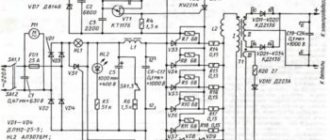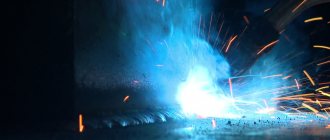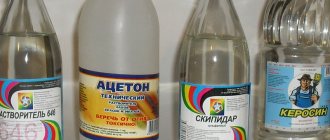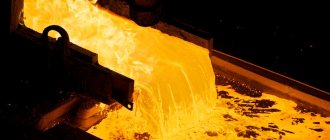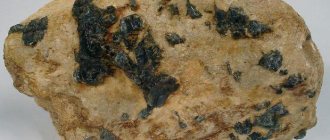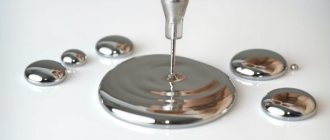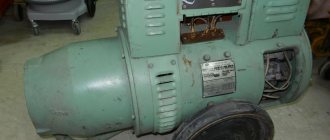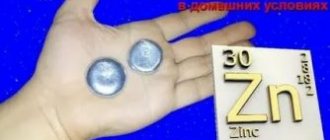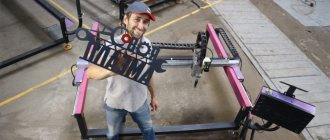4.2. Types of flame
Depending on the ratio between oxygen and acetylene, three main types of welding flame are obtained:
- normal;
- oxidative;
- carburizing
Depending on the type of material being welded, the welding flame is adjusted as follows:
| Metal to be welded | Carburizing flame | Normal flame | Oxidizing flame |
| Steel | — | + | — |
| Cast iron | + | 0 | — |
| Copper | — | + | — |
| Brass | — | — | + |
| Aluminum | + | 0 | + |
Table 6. Selecting the type of welding flame (18)
“+” - welds well; 0—possible; “-“ - poorly welded
Normal flame
A normal flame is obtained when slightly more, from 1.1 to 1.3 volumes of acetylene, is supplied to the burner per volume of oxygen. A normal flame is characterized by the absence of free oxygen and carbon in the reduction (working) zone.
A little more oxygen is supplied to the burner due to its low contamination and the consumption of hydrogen combustion. In a normal flame, all three zones are clearly visible.
Rice. 60. Structure of a normal flame (18)
Oxidizing flame
An oxidizing flame is produced when there is an excess of oxygen, when more than 1.3 volumes of oxygen are supplied to the burner per volume of acetylene. In this case, the core acquires a cone-shaped shape, is significantly reduced in length, becomes less sharp in outline and acquires a paler color. The working area and torch are also reduced in length. The entire flame takes on a bluish-violet color. The flame burns with noise, the level of which depends on the oxygen pressure. The temperature of the oxidizing flame is higher than the temperature of the normal flame. The oxidizing flame can be used in brass welding and brazing.
Such a flame strongly oxidizes the metal being welded, which leads to a brittle and porous weld and burnout of useful impurities of silicon and manganese. You can use an oxidizing flame when welding steels, but it is necessary to use filler wire, which has a high content of manganese and silicon, which are deoxidizing agents.
Rice. 61. Structure of the oxidizing flame (18)
Carburizing flame
A carburizing flame is produced when there is an excess of acetylene, when 0.95 or less volumes of oxygen are supplied to the burner per volume of acetylene. The core of such a flame loses the sharpness of its outline, and a green rim appears at its end, which is used to judge the excess of acetylene. The working area is much lighter and almost merges with the core, and the torch acquires a yellowish color. With a greater excess of acetylene, the flame begins to smoke, since there is a lack of oxygen necessary for complete combustion of acetylene. Black flakes of soot fly around the welding area. Excess acetylene decomposes into hydrogen and carbon. The carbon goes into the weld metal, so the acetylene flame will carbonize the weld metal.
The temperature of the carburizing flame is lower than that of the oxidizing and normal flames.
Rice. 62. Structure of the carburizing flame (18)
Rice. 63. Carburizing flame. Photo by the author
www.e-ope.ee
Color characteristic
Emissions of different flame colors are caused by electronic transitions. They are also called thermal. Thus, as a result of combustion of a hydrocarbon component in air, a blue flame is caused by the release of the HC compound. And when CC particles are emitted, the torch turns orange-red.
It is difficult to consider the structure of a flame, the chemistry of which includes compounds of water, carbon dioxide and carbon monoxide, and the OH bond. Its tongues are practically colorless, since the above particles, when burned, emit radiation in the ultraviolet and infrared spectrum.
The color of the flame is interconnected with temperature indicators, with the presence of ionic particles in it, which belong to a certain emission or optical spectrum. Thus, the combustion of certain elements leads to a change in the color of the fire in the burner. Differences in the color of the torch are associated with the arrangement of elements in different groups of the periodic system.
Fire is examined with a spectroscope for the presence of radiation in the visible spectrum. At the same time, it was found that simple substances from the general subgroup also cause a similar coloration of the flame. For clarity, sodium combustion is used as a test for this metal. When brought into the flame, the tongues turn bright yellow. Based on the color characteristics, the sodium line is identified in the emission spectrum.
Alkali metals are characterized by the property of rapid excitation of light radiation from atomic particles. When non-volatile compounds of such elements are introduced into the fire of a Bunsen burner, it becomes colored.
Spectroscopic examination shows characteristic lines in the area visible to the human eye. The speed of excitation of light radiation and the simple spectral structure are closely related to the high electropositive characteristics of these metals.
Gas welding. Composition and structure of the welding flame. Interaction of flame with metal.
Oxy-acetylene flame welding is effective in repair work. However, this is a low-productivity process that requires a highly qualified welder.
Gas welding uses a high-temperature flame produced by the combustion of acetylene gas mixed with oxygen to heat and melt metal. In some cases, instead of acetylene, its substitutes can be used: propane-butane, methane, gasoline or kerosene vapor, MAF.
Combustible gas and oxygen from cylinders (or a special gas generator) enter the welding torch, where they are mixed in a certain ratio and ignited at the exit from the nozzle. The flame melts the edges of the work being welded and the filler wire, and also serves as protection for the molten metal from the atmosphere. Adjustment of oxygen and fuel gas flow is carried out by appropriate valves.
The acetylene-oxygen flame consists of three zones: core –1, reduction (middle) zone – 2 and torch –3. In the first zone, pyrogenic decomposition of acetylene occurs in the presence of oxygen into carbon and hydrogen; in the second, the combustion of carbon in oxygen coming from the burner; in the third - further oxidation of the products of combustion and decomposition reactions (CO and H2) with oxygen sucked in from the environment. The maximum temperature develops in the middle zone, in which the welded metal is located.
Structure and types of gas flame (a) and their temperature characteristics (b); 1 – core, 2 – reduction zone, 3 – torch.
If the volume of oxygen is less than the volume of acetylene, then when acetylene is burned, free carbon atoms will remain, which will increase the carbon content in the surface layers of the metal. This is sometimes used to strengthen the surface layers of the product.
If the flame contains excess oxygen, it strongly oxidizes the metal. This flame is called oxidizing and is usually used only for heating metal.
Multi-station welding transformers
In large welding shops, welding stations can be located in separate groups at a great distance from each other. In this case, groups of posts can be powered from a multi-station welding transformer. Welding stations are connected to the transformer in parallel to each other. The main condition for stable operation with multi-post feeding is the independence of the operating mode of each post from the operation of other posts. To achieve this, it is necessary that the power supply voltage does not change with changes in load, i.e. The external current-voltage characteristic of the power supply must be rigid.
For multi-station welding, you can use a transformer with normal dissipation, which has a rigid current-voltage characteristic.
Connection diagram of welding stations to a transformer with normal dissipation
For multi-station welding, three-phase transformers are used with parallel power supply to several welding stations.
The phase voltage should be 65-70 V. Regulation of the welding current and the formation of the falling characteristic at each station is carried out using a choke or ballast rheostat.
The number of posts that can be connected to the power source can be calculated using the formula.
– number of posts
– rated current of the multi-station welding transformer
– welding current of the station
– load factor.
Multi-station welding transformers have disadvantages: large voltage and energy losses in the low-voltage welding circuit; in the event of a failure of a multi-station transformer, a large number of welding stations will be idle. To avoid this, it is necessary to have redundant transformers, which increases equipment costs. These disadvantages limit the use of multi-post transformers; for the same reasons, the number of posts does not exceed 9 - 12.
studfiles.net
Gas welding technology
Details Details Published 05/27/2012 13:: 9638
Welding torch flame
A welding flame is formed by the combustion of gaseous fuel or vapor of a flammable liquid in pure oxygen.
The welding flame heats and melts the metal of the workpiece and filler wire at the welding site, resulting in the formation of a weld pool. The appearance, temperature and nature of the influence of the welding flame on the molten metal depend on what kind of fuel is supplied to the burner and in what volumetric ratio it is with oxygen. By changing the amount of oxygen and combustible gas entering the torch, the welder changes the composition of the combustible mixture and thereby changes the welding flame - its appearance, temperature, composition of combustion products, its properties, etc.
The figure shows diagrams of different types of oxyacetylene flame: normal, oxidizing and carburizing.
Theoretically, a normal flame is obtained when one volume of oxygen is supplied to the burner for one volume of acetylene. In practice, due to some oxygen contamination, a normal flame is formed with a slightly larger amount of oxygen - from 1.1 to 1.3 of the volume of acetylene.
A normal oxyacetylene flame has three clearly distinguishable zones: the core, the reducing (middle zone) and the torch (oxidizing zone).
The core has a sharply defined, slightly barrel-shaped shape with a rounded end. Inside the core there is a mixture of oxygen and acetylene that has not yet burned. The shell of the core glows brightly, as it consists of hot carbon particles. The inner part of the kernel has a bluish color, the core temperature is about 900° C.
The recovery (middle) zone has a slightly bluish color. It consists of the products of incomplete combustion of acetylene - carbon monoxide and hydrogen, which deoxidize the molten metal, that is, they remove oxygen from the metal oxides present in the weld pool. The process of removing oxygen from metal oxides is called reduction, which is why this flame zone is called the reducing zone. If welding is carried out in such a way that the molten metal of the weld pool is in the reduction zone, then the weld metal is obtained without inclusions of oxides, pores, gas bubbles and other defects. The reduction zone has the highest temperature in a place 3-6 mm from the end of the flame core (about 3200°C). When welding, the molten metal must be at a specified distance from the end of the flame core.
The torch, or oxidation zone, is located behind the reduction zone. It consists of carbon dioxide (carbon dioxide), water vapor and nitrogen, which appear in the flame during the combustion of carbon monoxide and hydrogen of the reduction zone due to the oxygen of the surrounding air. For this reason, the temperature of the torch is significantly lower than the temperature of the reduction zone, and ranges from 1200-2500 ° C.
An oxidizing flame occurs when the combustible mixture contains more than 1.3 volumes of oxygen per volume of acetylene. In this case, the core takes on a cone-shaped shape, is significantly reduced in length, becomes less distinct and acquires a paler color. The reduction zone and the torch are reduced in length, the entire flame becomes shorter and acquires a bluish-violet color. The flame burns with noise, the degree of which depends on the oxygen pressure and the gas mixture ratio. The higher the oxygen content in the mixture, the louder the flame burns. The temperature of an oxidizing flame is higher than a normal one, but it cannot weld steel, since due to the presence of excess oxygen in the flame, the metal being welded will oxidize, and the seam will be porous and brittle.
A carburizing or, as it is sometimes called, an acetylene flame is produced by feeding less than one volume of oxygen per volume of acetylene into the burner. The flame core loses the sharpness of its outline, becomes blurry, and a green rim appears at the end of the core, which indicates an excess of acetylene. The reduction zone is lighter and almost merges with the core, the boundary between the reduction zone and the torch completely disappears; the torch acquires a yellowish color. With a large excess of acetylene, the flame begins to smoke, that is, there is a lack of oxygen necessary for complete combustion of acetylene. Excess acetylene decomposes into carbon and hydrogen. Carbon easily dissolves in the molten metal and degrades the quality of the weld. The temperature of the carburizing flame is lower than the normal flame.
The nature of the welding flame is determined by the welder by eye by its shape and color. When adjusting the burner flame, you should select the correct oxygen pressure. If the oxygen pressure is too high, the mixture flows out of the burner mouthpiece at too high a speed and the flame becomes “hard”. Such a flame blows out the molten metal of the weld pool and makes the welding process difficult. If the oxygen pressure is too high, the flame breaks away from the end of the mouthpiece, and if it is too low, the flame is shortened and backlashes occur as the burner mouthpiece approaches the metal.
With the oxygen pressure set correctly, the flame will be even and steady burning. The quality of the deposited metal and the strength of the weld largely depend on the nature of the flame. Therefore, the welder must always pay great attention to the appearance of the welding flame and adjust it correctly. The flame has to be adjusted throughout the welding process, since when the torch tip is heated, the composition of the gases in the mixture changes, in particular, the amount of acetylene decreases. Therefore, when initially adjusting the flame, it is necessary to leave some “reserve of acetylene”, for which the acetylene valve on the burner should not be completely open. In this case, when welding, as the torch heats up and the amount of acetylene in the gas mixture decreases, the welder, without stopping the welding process, adds acetylene, opening the valve with the thumb of his right hand.
Different metals require different flame patterns. So, for example, when welding cast iron, chromium steels and surfacing hard alloys, the flame is taken with a slight excess of acetylene, and when welding brass - with an excess of oxygen.
The welding flame must have sufficient thermal power, i.e., provide the amount of heat necessary to melt the metal being welded and cover heat losses to the base metal and the environment. The greater the thickness of the metal being welded and the greater its thermal conductivity coefficient, the greater the power of the torch. With a decrease in the melting temperature of the metal and an increase in the angle of inclination of the burner mouthpiece, the required flame power can be reduced. The power of the flame is judged by the number of liters of acetylene consumed by the burner per hour: the more acetylene consumed, the greater the power of the flame. The burner tip sometimes indicates how many liters of acetylene are burned per hour.
electrowelder.ru
Burning candle
Burning a candle is similar to burning a match or lighter. And the structure of a candle flame resembles a hot gas stream, which is pulled upward due to buoyant forces. The process begins with heating the wick, followed by evaporation of the wax.
The lowest zone, located inside and adjacent to the thread, is called the first region. It has a slight blue glow due to a large amount of fuel, but a small volume of oxygen mixture. Here, the process of incomplete combustion of substances occurs with the release of carbon monoxide, which is subsequently oxidized.
The first zone is surrounded by a luminous second shell, which characterizes the structure of the candle flame. A larger volume of oxygen enters it, which causes the continuation of the oxidation reaction with the participation of fuel molecules. Temperatures here will be higher than in the dark zone, but not sufficient for final decomposition. It is in the first two areas that when droplets of unburned fuel and coal particles are strongly heated, a luminous effect appears.
The second zone is surrounded by a low-visibility shell with high temperature values. Many oxygen molecules enter it, which contributes to the complete combustion of fuel particles. After the oxidation of substances, the luminous effect is not observed in the third zone.
Welding flame composition
Semi-automatic arc welding machines and their main components
The appearance, temperature and influence of the welding flame on the molten metal depend on the composition of the combustible mixture, i.e. the ratio of oxygen and acetylene in it. By changing the composition of the combustible mixture, the welder changes the properties of the welding flame. When acetylene burns in air without the addition of oxygen, the flame has a yellowish color and a long flame without a light core. Such a flame is not suitable for welding, as it has a low temperature and smokes, releasing a lot of soot (unburned carbon). If oxygen is added to such a flame by opening the oxygen valve of the burner, the color and shape of the flame will change sharply, and its temperature will increase. By changing the ratio of oxygen and acetylene in the combustible mixture, it is possible to obtain three main types of welding flame (Fig. 95): carburizing (with an excess of acetylene); normal (called recovery); oxidizing (with excess oxygen). For welding most metals, a normal (reduction) flame is used. Theoretically, it is obtained if one volume of oxygen is supplied to the mixture for one volume of acetylene. Acetylene burns due to the oxygen in the mixture according to the reaction: C2H2 + O2 = 2CO + H2 (combustion phase 1) Further combustion occurs due to oxygen, which comes from the surrounding air, according to the reaction: 2CO + H2 + 1.5O2 = 2CO2 + h3O.
(phase 2 of combustion) Carbon monoxide and hydrogen formed in the flame deoxidize the metal, reducing the metal in the weld pool from the oxides. When using a mixture with a 1:1 volume ratio of oxygen and acetylene, the weld metal is quite homogeneous, without pores, gas bubbles and oxide inclusions. A practically normal reduction flame is obtained when there is an excess of oxygen in the mixture of up to 30% compared to the theoretical due to its supply from the ambient air. Thus, the ratio of acetylene and oxygen changes from 1:1 to 1:1.3. A normal flame has a light core, a somewhat dark reduction zone and a torch.
Rice. 95. Types of acetylene-oxygen flame: a - carburizing; b - normal; c - oxidative; 1 - core; 2 - recovery zone; 3 - torch
The core has a clearly defined shape, close to the shape of a cylinder with a rounded end, and a brightly glowing shell, which consists of hot carbon particles. The combustion of these particles occurs in the outer layer of the shell. The dimensions of the flame core are its diameter and length. The diameter of the flame core is determined by the diameter of the mouthpiece channel and the flow rate of the combustible mixture. The burners are equipped with a set of mouthpieces of several numbers. The larger the number of the mouthpiece and the consumption of the combustible mixture, the larger the diameter of the core. The length of the flame core is determined by the flow rate of the gas mixture. The flow rate of the gas mixture is the main factor determining the stability of the flame. At a low flow rate of the gas mixture, the flame is prone to the formation of pops and backfires. When the flow rate of the gas mixture is too high, the flame blows the molten metal out of the weld pool. The reduction zone has a darker color, different from the color of the core and the rest of the flame. It occupies a space within 20 mm of the end of the core, depending on the number of the mouthpiece. The reduction zone consists of carbon monoxide and hydrogen and has the highest temperature at a point 2-6 mm from the end of the core. This flame zone heats and melts the metal during the welding process. The rest of the flame, located behind the reduction zone, is called a torch and consists of carbon dioxide, water vapor and nitrogen, which appear in the flame during the combustion of carbon monoxide and hydrogen of the reduction zone due to the oxygen of the surrounding air. The flame temperature is significantly lower than the temperature of the reduction zone. Thus, in the reduction zone, at a point slightly further from the end of the core, the maximum temperature of the acetylene-oxygen flame of 3150 ° C is reached. With a methane-oxygen flame, the maximum temperature is 2150 °
C, can be achieved at a distance of 3-3.5 core lengths from the cut of the burner mouthpiece. The propane-butane-oxygen flame reaches a maximum temperature of 2400 °C at a distance of 2.5 core lengths from the mouthpiece cut. These approximate data allow the welder to use the torch flame most efficiently when welding metal of a given thickness. An oxidizing flame is obtained by increasing the supply of oxygen or reducing the supply of acetylene to a volume of oxygen in the mixture that is 1.3 times the volume of acetylene. The oxidizing flame has a shortened, pointed core with less sharp outlines and a pale color. The temperature of the oxidizing flame is higher than the temperature of the normal reducing flame. Such a flame strongly oxidizes the metal being welded, which leads to a brittle and porous weld and burnout of useful impurities of silicon and manganese. You can use an oxidizing flame when welding steels, but it is necessary to use filler wire, which has a high content of manganese and silicon, which are deoxidizing agents. A carburizing flame is produced by decreasing the oxygen supply or increasing the acetylene supply. It is formed when 0.95 or less volume of oxygen per volume of acetylene is supplied to the burner. In a carburizing (acetylene) flame, the size of the combustion zone increases, the core loses its sharp outline, becomes blurry, and a green rim appears at the end of the core, which indicates the presence of excess acetylene. The reduction zone brightens and almost merges with the core, the flame takes on a yellowish color. With a large excess of acetylene, the flame becomes smoky, since there is not enough oxygen and complete combustion of acetylene does not occur. Excess acetylene decomposes into hydrogen and carbon. The carbon goes into the weld metal, so the acetylene flame will carbonize the weld metal. The temperature of this flame is lower than the temperature of a normal flame. If you reduce the supply of acetylene to the burner until the green rim at the end of the core completely disappears, the acetylene flame can be turned into a normal flame. Flames with excess acetylene are used for surfacing hard alloys, as well as for welding aluminum and magnesium alloys. The quality of the deposited metal and the strength of the weld depend on the composition of the welding flame. Therefore, the welder must pay special attention to the nature and correct regulation of the welding flame. The nature of the flame is determined by the welder by eye by the shape and color of the flame. When forming a seam, two main factors are taken into account: the angle of inclination of the mouthpiece; flow rate of the gas mixture. The welding flame must have sufficient thermal power, which is selected depending on the thickness of the metal being welded and its physical properties. By changing the thermal power of the flame, it is possible to regulate the rate of heating and melting of the metal within a fairly wide range, which is one of the positive qualities of the gas welding process. However, it should be remembered that the efficiency of using the calorific value of the fuel during gas welding is only 7%. The heat released during the combustion of acetylene is consumed as follows, %: Usefully used for welding to melt the metal Heat loss: 6-7 from incomplete combustion 5563 with exhaust gases 13-15 for radiation and convection 9-10 for heating areas adjacent to the seam 15 -18 from fumes and metal spattering
1-2
Methods for quality control of welded joints can be divided into two main groups: methods of control without destruction of samples or products - non-destructive testing; methods of control with destruction of samples or production joints...
The most common types of defects in welds
The operational reliability of welded joints depends on their compliance with regulatory and technical documentation, which regulates the structural dimensions and shape of finished welds, strength, ductility, corrosion resistance and properties of welded joints. Welded joints made...
Fire prevention measures
To prevent fires, the following fire safety measures must be observed. Constantly monitor the availability and proper condition of fire-fighting equipment (fire extinguishers, boxes of dry sand, shovels, fire hoses, asbestos blankets, etc.). ...
msd.com.ua
